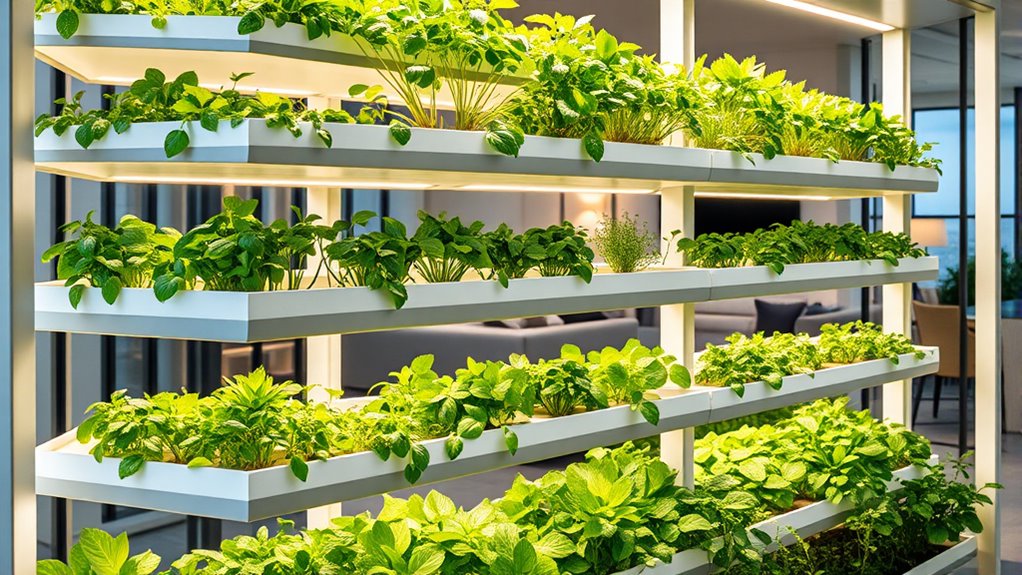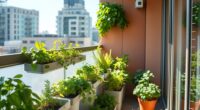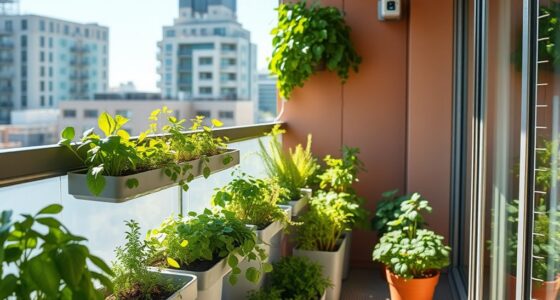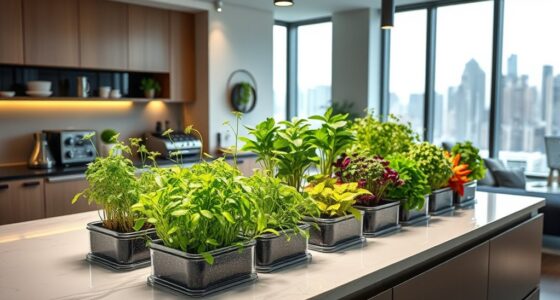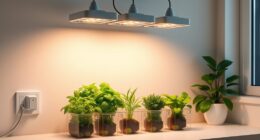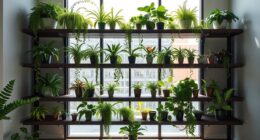With a modular indoor garden, you can design a customizable farm that adapts as your space and needs change. Choose flexible components like hydroponic modules, adjustable lighting, and scalable layouts to create the perfect environment for your plants. Reconfigure and expand your setup easily to suit different crops or space constraints. Implement smart technology for automation and keep your garden thriving. Keep exploring to discover how to build and maintain your growing indoor farm effectively.
Key Takeaways
- Use modular components to customize and expand your indoor garden as your needs evolve.
- Incorporate adjustable lighting, ventilation, and nutrient systems for optimal growth control.
- Plan flexible layouts that maximize space efficiency and accommodate different plant types.
- Implement smart technology and automation for consistent maintenance and environmental monitoring.
- Choose eco-friendly materials and creative design elements to personalize and enhance your indoor farm.
Understanding Modular Indoor Garden Systems
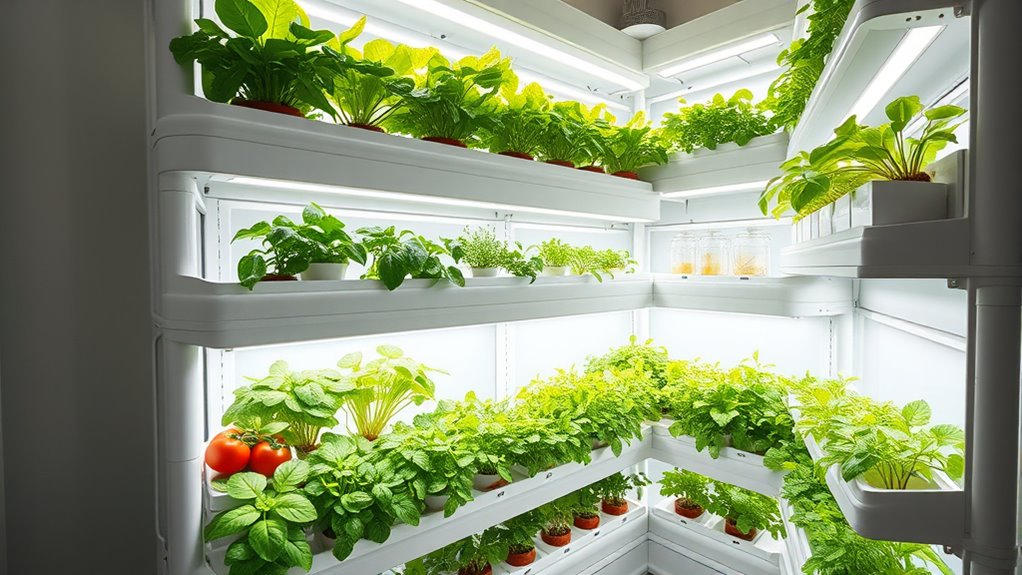
Modular indoor garden systems are designed to give you flexibility and control over your growing environment. These systems often feature hydroponic setups, allowing you to grow plants without soil, which maximizes space and efficiency. You can easily customize each module to suit different plant types or growth stages. Lighting solutions are integral to these systems, providing the necessary spectrum and intensity to promote healthy growth indoors. With adjustable LED lights, you can simulate natural sunlight or optimize light cycles for specific plants. This adaptability means you don’t need to be an expert to start; instead, you can experiment and refine your setup as you learn. Additionally, materials range from ceramic to recycled products, ensuring that your modular garden can be both eco-friendly and aesthetically pleasing. Modular systems empower you to create a personalized, scalable garden that adapts to your needs and space constraints.
Benefits of Customizable Farm Designs
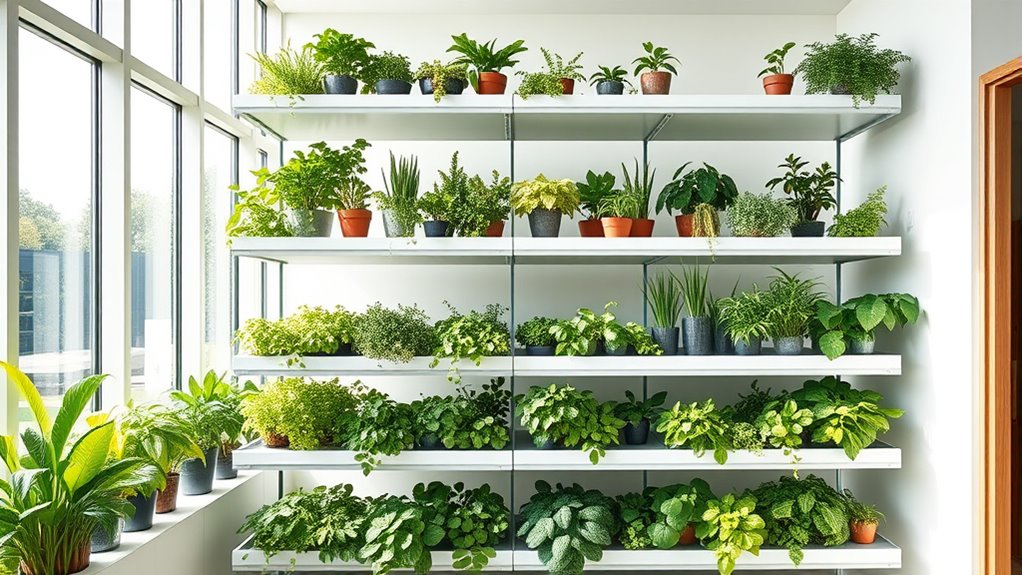
With customizable farm designs, you can create a layout that fits your space and needs perfectly. You also get to choose the plants that suit your preferences and goals. This flexibility makes your indoor garden more efficient and enjoyable to maintain. Additionally, planning your layout carefully can help optimize space and resources for better cost management.
Flexible Layout Options
Have you ever considered how a customizable indoor garden can adapt perfectly to your space and needs? Flexible layout options allow you to design a farm that suits your environment and goals. For example:
- Rearrange modules to optimize garden aesthetics and improve light exposure.
- Expand or reduce sections based on your space or harvest goals.
- Customize planting zones to enhance plant nutrition and growth efficiency.
- Integrate different plant types for visual diversity and functional purposes.
- Monitoring storage conditions such as humidity and temperature ensures your crops stay fresh and healthy.
This adaptability ensures your indoor farm remains functional and visually appealing as it evolves. You can focus on creating a space that’s both efficient for growth and pleasing to the eye. Flexible layouts make it easier to grow more, while maintaining control over your indoor environment’s look and performance.
Personalized Plant Selection
Why settle for generic plants when you can tailor your indoor garden to suit your personal tastes and goals? Personalized plant selection lets you choose varieties that match your culinary preferences, aesthetic, and space. This flexibility enhances plant diversity, offering a broader range of flavors and visual appeal. Plus, selecting specific plants can improve pest management, as diverse crops reduce the risk of infestations spreading. To illustrate, here’s a quick overview:
| Plant Type | Benefits |
|---|---|
| Leafy Greens | Fast-growing, high nutrients |
| Herbs | Aromatic, easy to maintain |
| Tomatoes | Versatile for cooking |
| Microgreens | Nutrient-dense, space-saving |
| Peppers | Adds spice, visual interest |
Incorporating a variety of plants also supports mindful decluttering by helping you focus on what truly enhances your space and well-being.
Choosing the Right Components for Your Setup
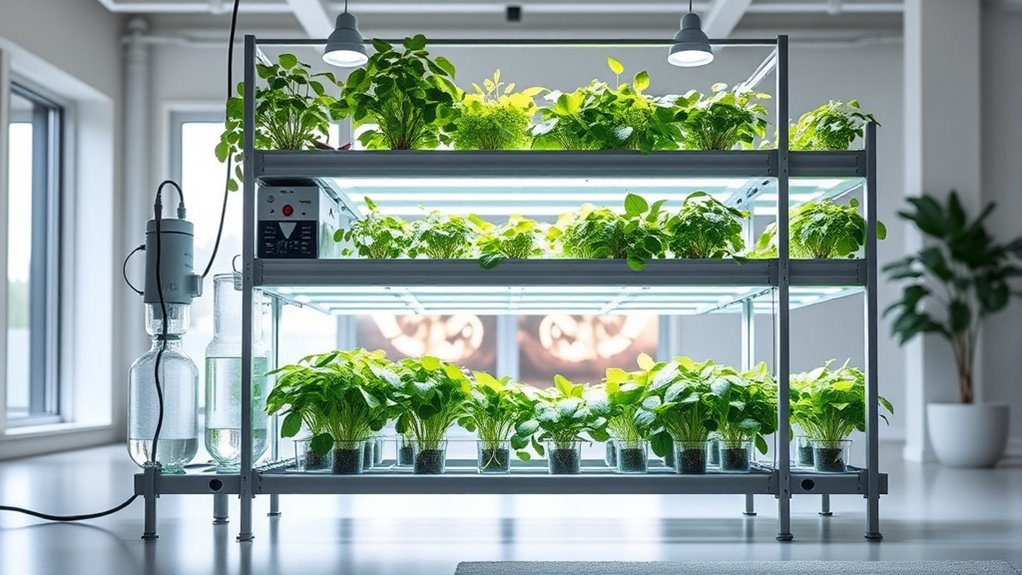
Selecting the right components is essential to creating an efficient and productive indoor garden. To get started, consider these key elements:
- Lighting: Choose grow lights suited for your plants’ needs, ensuring they receive adequate energy.
- Plant nutrient solutions: Select nutrient mixes tailored to your plants’ growth stages, promoting healthy development.
- Pest control methods: Incorporate non-toxic solutions like neem oil or traps to manage pests effectively without harming your plants.
- Ventilation: Guarantee proper airflow with fans or vents to prevent mold and regulate temperature.
- Smart technology: Implementing AI-driven solutions can optimize environmental conditions and improve plant health monitoring.
Planning Your Indoor Garden Space
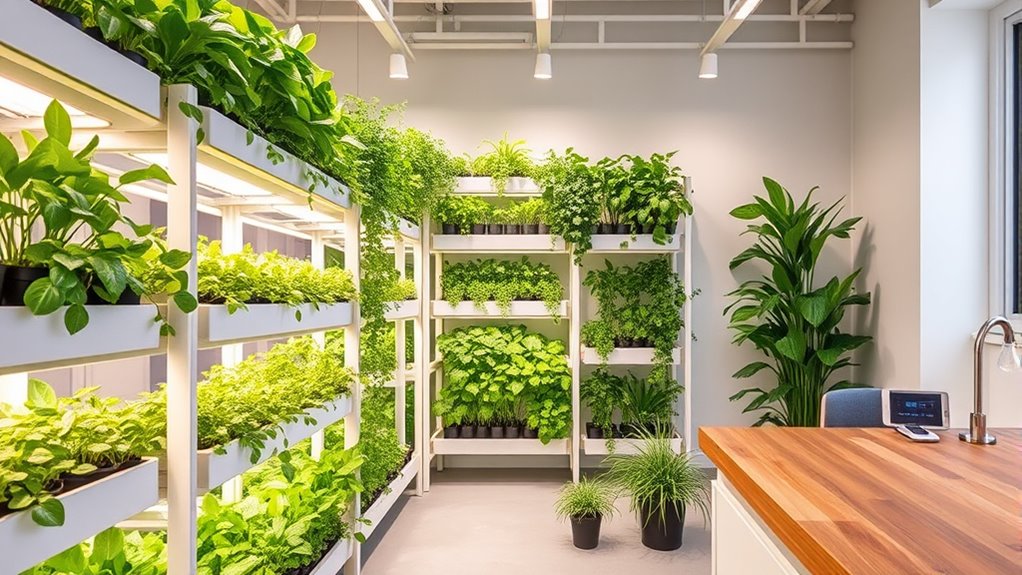
Planning your indoor garden space begins with evaluating the area where you’ll set up your system. Consider the layout to optimize garden aesthetics, ensuring your setup looks appealing and fits your space. Think about natural light sources and whether you need supplemental grow lights. Leave enough room for plant growth and easy access for maintenance. Proper space planning also helps with pest control; a well-organized layout reduces hiding spots for pests and makes monitoring easier. Avoid clutter and overcrowding, which can hinder airflow and promote disease. Measure dimensions carefully and choose modular components that fit comfortably within your space. Incorporating color accuracy into your lighting choices can enhance plant growth and visual appeal. By thoughtfully planning, you create a functional, attractive indoor garden that grows with you and stays healthy over time.
Installing and Assembling Your Modular System
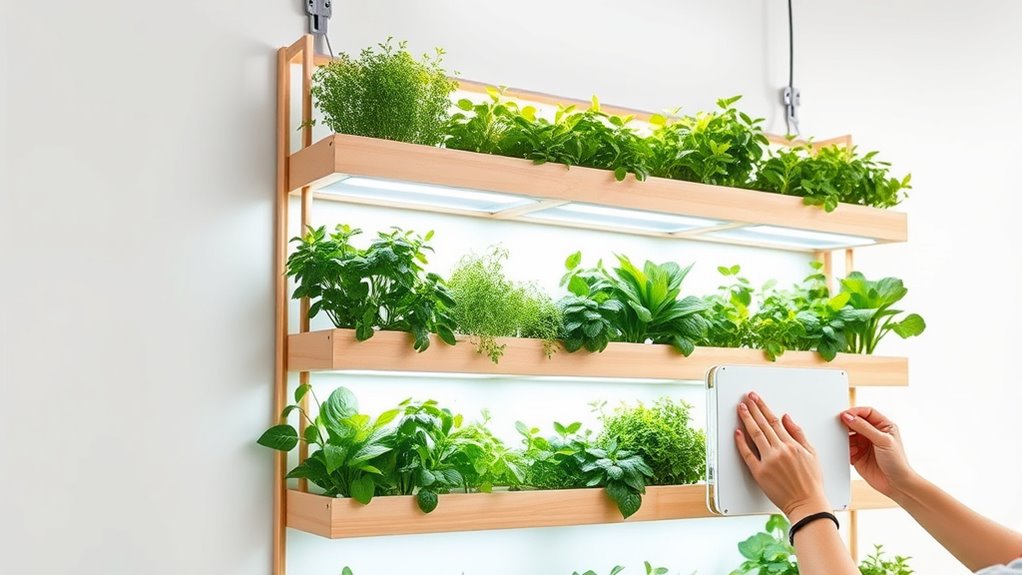
To get started, you’ll need to choose the right components that fit your space and needs. Follow a clear step-by-step assembly guide to put everything together efficiently. Remember to secure all connections tightly to guarantee your system stays stable and safe. Incorporating IoT technologies can further optimize your indoor garden by providing automated monitoring and adjustments.
Choosing the Right Components
When assembling your modular indoor garden system, choosing the right components guarantees a smooth installation process and long-term success. Focus on selecting quality materials that support healthy plant growth and pest management. First, pick containers with proper drainage to prevent waterlogging. Second, choose soil with high soil quality, rich in nutrients and well-aerated. Third, select grow lights suitable for your plant types, ensuring proper light spectrum and intensity. Fourth, consider incorporating pest barriers or organic pest control tools to keep pests at bay. These components work together to create a thriving environment. Additionally, understanding resources and tools available can help you optimize your setup and troubleshoot issues as your garden grows. Making thoughtful choices now guarantees your garden remains healthy, productive, and adaptable as it grows with you.
Step-by-Step Assembly Guide
Begin by carefully unpacking all your modular components and laying them out in a clean, organized space. This guarantees smooth assembly and easy access. Follow these steps:
| Step | Action | Tips |
|---|---|---|
| 1 | Connect the frame pieces | Guarantee tight, secure connections |
| 2 | Install shelves or trays | Position for ideal seed propagation |
| 3 | Attach lighting systems | Maintain consistent light exposure |
| 4 | Add ventilation components | Prevent pests and mold |
As you assemble, verify each connection is firm to support your growing plants and prevent pest issues. Secure assembly provides stability for seed propagation while minimizing entry points for pests. Take your time to align components properly for a seamless setup. Additionally, ensure that your modular system is adaptable for future expansion or reconfiguration, allowing your indoor garden to grow with your needs.
Tips for Secure Connections
Ensuring your modular components connect securely is key to building a stable and pest-resistant indoor garden. Proper connections improve garden aesthetics and prevent pests from slipping in through gaps. To achieve this, follow these tips:
- Use locking mechanisms or clips to firmly secure panels and shelves.
- Tighten all bolts and screws regularly to maintain stability.
- Check that all joints are flush and aligned for a seamless look.
- Seal any gaps with food-safe, pest-resistant sealants to enhance pest control.
- Incorporate proper ventilation to prevent moisture buildup and discourage pest infestations.
Tips for Maintaining a Thriving Indoor Garden
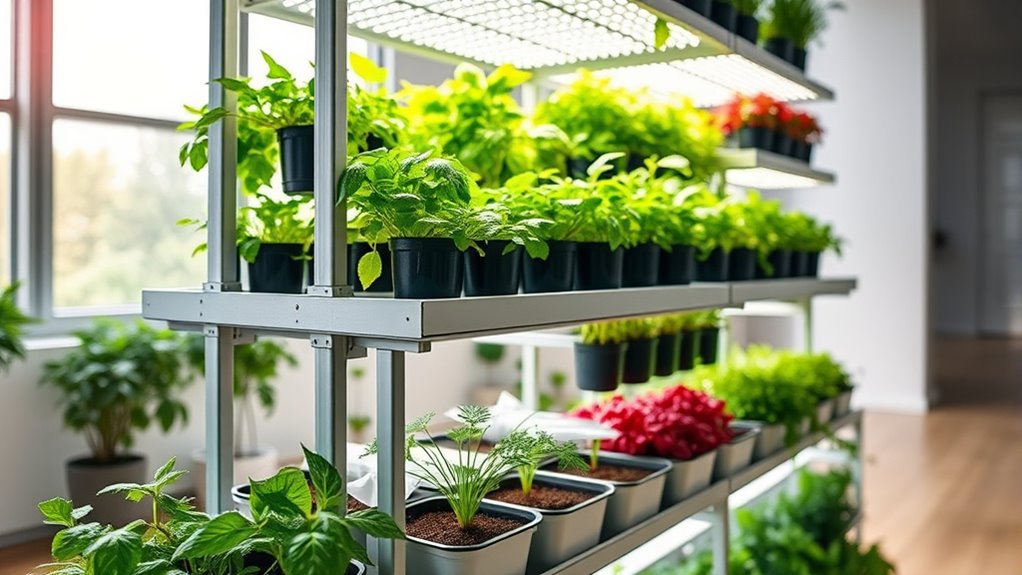
Maintaining a thriving indoor garden requires consistent attention to several key factors. First, monitor pest control regularly to prevent infestations that can damage your plants. Keep an eye out for common pests like aphids or spider mites and address issues early with natural or organic solutions. Equally important is maintaining soil quality; healthy soil provides essential nutrients for your plants’ growth. Use quality soil and consider supplementing with organic fertilizers to boost vitality. Guarantee proper watering—not too much or too little—to avoid root rot or drought stress. Proper lighting and air circulation also support plant health. Regularly remove dead leaves and debris to prevent disease. Additionally, understanding juice extraction techniques can be beneficial if you incorporate edible plants and herbs into your indoor garden. With diligent care, your indoor garden will stay lush, productive, and resilient.
Scaling Your Garden: Expanding and Reconfiguring
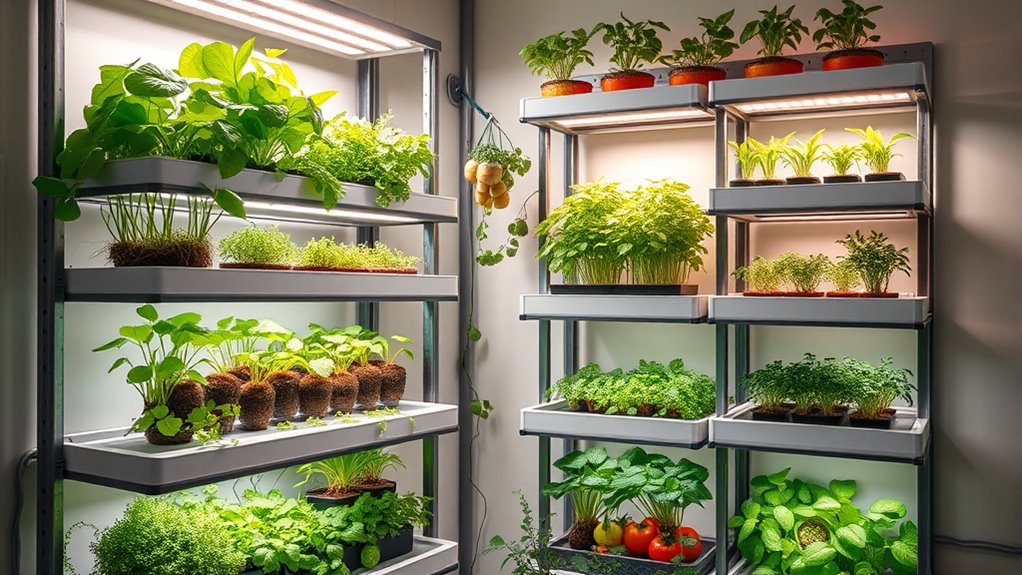
Scaling your indoor garden involves thoughtful planning to expand your space or reconfigure existing setups for maximum efficiency. To do this effectively:
Expanding your indoor garden requires careful planning for efficient growth and reconfiguration.
- Assess your current hydroponic systems and identify areas for expansion or reconfiguration.
- Choose modular components that allow easy reorganization as your needs grow.
- Expand gradually, ensuring your pest management strategies remain effective across larger areas.
- Optimize lighting and airflow to prevent pest issues and maintain plant health during reconfiguration.
- Incorporate analytics tools to monitor growth trends and optimize resource allocation during scaling.
Integrating Technology for Automated Growth
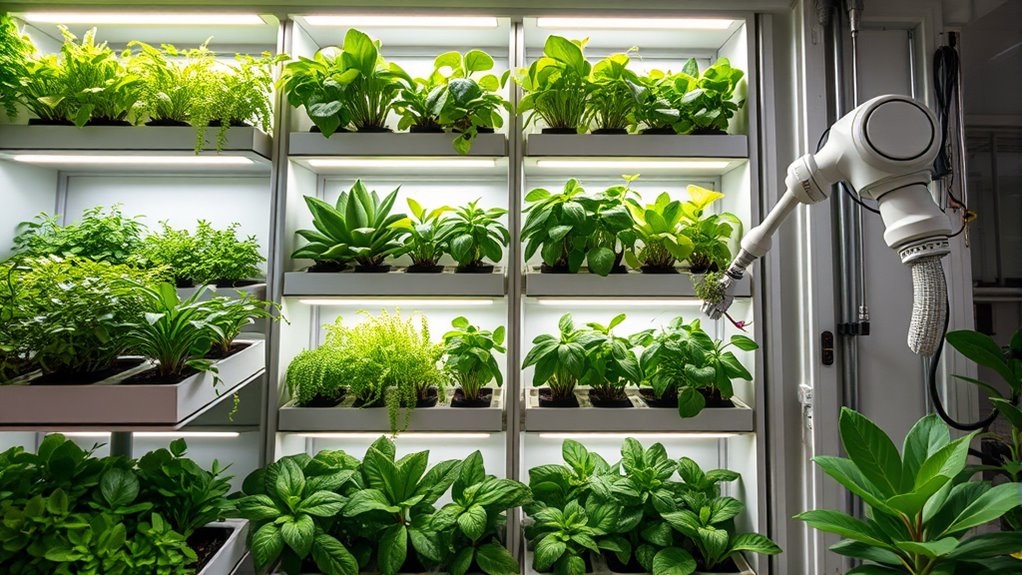
Integrating technology into your indoor garden can substantially enhance growth efficiency and reduce manual effort. Hydroponic systems enable you to grow plants without soil, maximizing nutrient delivery and accelerating growth cycles. Automated watering and nutrient dosing ensure your plants receive the right amount at the right time, minimizing waste and consistent results. Lighting automation is equally crucial; smart systems adjust LED lights based on the plant’s growth stage and time of day, providing ideal light spectra and intensity. These technologies work together to create a controlled environment that promotes healthy, rapid development with less oversight. Implementing such automation tools simplifies maintenance, saves you time, and ensures your indoor farm remains productive and thriving as it scales and adapts to your needs. Customer service can also assist with any questions about the technology or support your setup process.
Creative Ideas for Personalizing Your Indoor Farm
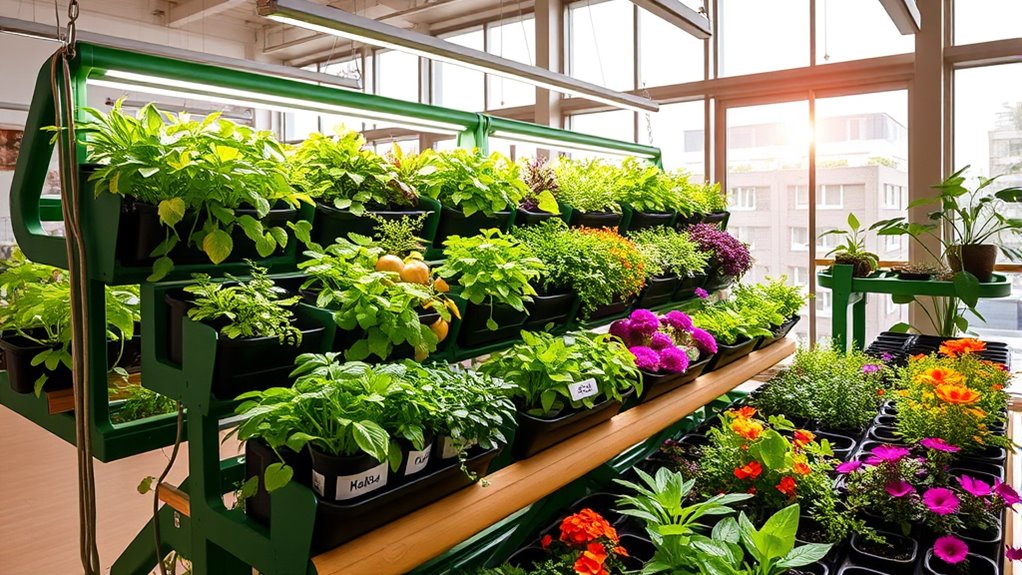
Personalizing your indoor farm transforms it from a generic space into a unique, inspiring environment that reflects your style and preferences. To do this, incorporate creative touches like garden art or decorative planters that match your decor. Here are some ideas:
Personalize your indoor farm with creative touches that showcase your unique style and inspire your green space.
- Use colorful or themed decorative planters to add visual interest and personality.
- Hang wall-mounted garden art or botanical prints to enhance the space’s aesthetic.
- Arrange plants in a layered setup, mixing different sizes and textures for depth.
- Incorporate quirky or artistic containers to make even small herbs or succulents stand out.
- Remember that dog-friendly environments can also be designed within your indoor garden, making it a safe and enjoyable space for your canine companions.
These touches turn your indoor farm into a personalized oasis, inspiring you to nurture your plants while showcasing your unique taste.
Frequently Asked Questions
What Are the Initial Costs Involved in Setting up a Modular Indoor Garden?
When considering the initial costs involved in setting up a modular indoor garden, you should focus on cost estimation and equipment expenses. You’ll need to budget for lighting, containers, growing medium, and climate control systems. While prices vary based on size and features, expect to spend a few hundred to a few thousand dollars initially. Planning ahead helps guarantee you have all necessary equipment while staying within your budget.
How Do I Troubleshoot Common Issues in a Modular Indoor Farm?
Think of your indoor garden as a symphony; every element must be in harmony. When issues arise, like pests or poor growth, start with pest control to keep unwanted guests out. Check your lighting adjustments—if plants seem leggy or dull, tweak your lights for ideal growth. Regularly monitor moisture and nutrient levels too. Troubleshooting is about fine-tuning each part until your garden plays a perfect tune.
Can Modular Indoor Gardens Support a Variety of Plant Species Simultaneously?
Yes, modular indoor gardens can support a variety of plant species simultaneously. You should consider plant compatibility and species diversity when designing your setup. By adjusting light, water, and nutrient levels for different plants, you create an environment that accommodates multiple species. This flexibility allows you to grow herbs, vegetables, and flowers together, maximizing space and creating a vibrant, diverse indoor garden tailored to your preferences.
What Maintenance Is Required to Keep the System Functioning Optimally?
To keep your indoor garden functioning at its best, you’ll need to follow a consistent watering schedule tailored to your plants’ needs. Regularly check for pests and manage them promptly to prevent damage. Keep the system clean by removing debris and monitoring humidity levels. Occasionally, replace or clean filters and lights. Staying attentive to these maintenance tasks ensures a healthy, thriving garden that grows with you.
Are There Eco-Friendly or Sustainable Options for Modular Indoor Garden Components?
Think of your garden as a living tapestry, woven with eco-conscious choices. You can opt for modular indoor garden components made from recyclable materials, reducing waste and environmental impact. Using organic growing mediums not only nurtures your plants naturally but also supports sustainability. These eco-friendly options let you cultivate a lush, vibrant garden while respecting the planet, ensuring your indoor farm grows harmoniously with nature’s rhythms.
Conclusion
With a modular indoor garden, you hold the power to transform any space into a lush, personal farm that grows alongside you. As you customize, expand, and fine-tune your setup, you’ll discover that your indoor garden can become as boundless as your imagination. Embrace this innovative approach—it’s not just a farm, but a gateway to a greener, healthier lifestyle that can outshine even the most sprawling outdoor landscapes. Your verdant sanctuary awaits; the possibilities are endless.
